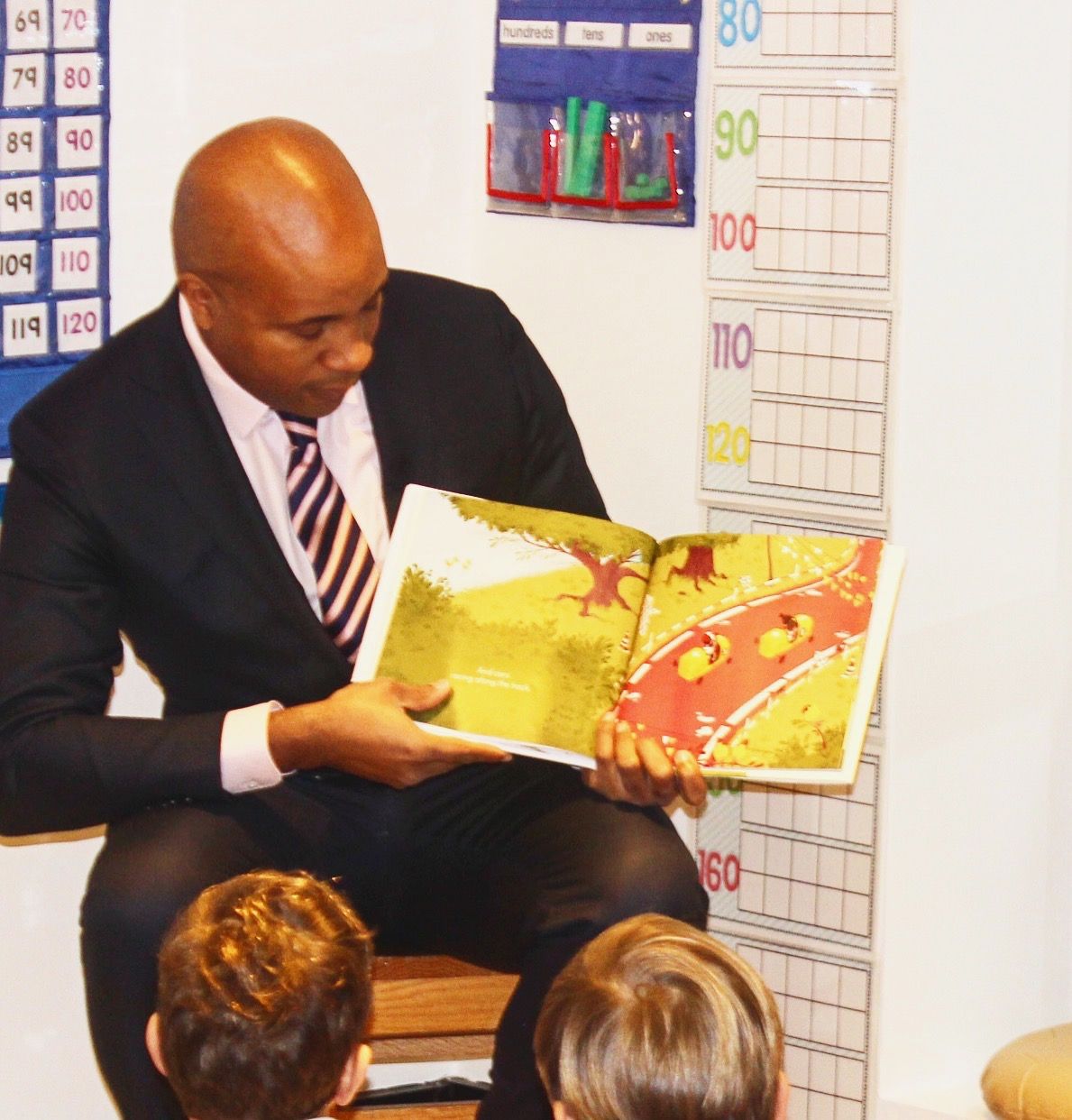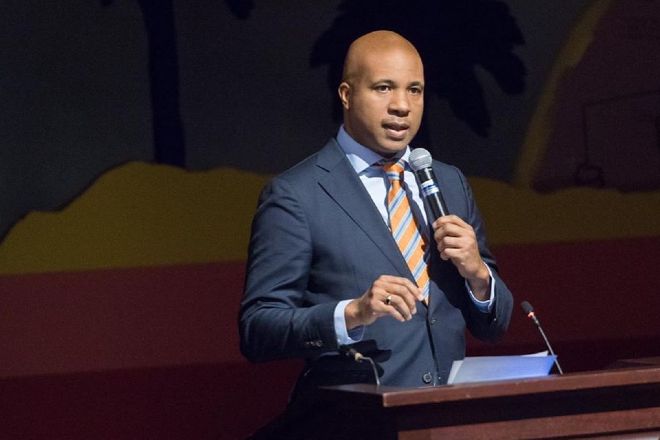Interview by Tara Kosowski
Feature image: Derrick Gay, Ed.D., delivering the Dr. Martin Luther King Jr. Keynote Address at The Latin School of Chicago.
Derrick Gay, Ed.D., is an internationally recognized consultant to schools, businesses and nonprofit and arts organizations on issues of diversity and inclusion, cultural competency and global citizenship. In addition to his direct work in the nursery-grade 12 world, Gay has been featured in the New York Times, Washington Post and NPR and has produced two TEDx talks. He taught in several independent schools before launching his consultancy. He currently teaches at Columbia University Business School in New York City and International Fashion Academy in Paris, France.
Net Assets: You work with K–12 schools and universities around the world — in France, Colombia and Brazil, for example — to establish best practices in diversity and inclusion efforts in a global context. We know that more independent schools are focusing on global education, be it through programming or international student exchange. What advice do you have for schools looking to offer deeper connections across communities?
Gay: I find that many schools are missing opportunities to align diversity and inclusion work with a global citizenship framework. Independent schools are increasingly comprised of people from different nationalities and countries of origin, yet many schools are not intentionally leveraging those different backgrounds and competencies beyond expanding cafeteria options or providing travel opportunities to domestic students.
It is critical to recognize that merely having a school with a faculty, staff, students and families from different countries of origins and backgrounds doesn’t automatically yield an inclusive environment. In fact, all the research finds that without intentionality around cultivating inclusion, the more diverse an environment — meaning the more types of differences represented — the less inclusive the environment. Why? Because in these environments people are able to create critical masses similar to them and not interact with people different to them in meaningful ways. So in the cafeteria we see the baseball team sits together, the thespians sit together, the students from China sit together, the domestic students of color sit together, the new teachers sit together, the staff sits together — often without mixing across groups.
As schools seek to create global communities that are diverse and inclusive, they should ask themselves, how can we bring students, employees and families from numerous backgrounds and countries together in meaningful ways? How can we recognize diversity (differences) while also ensuring that each individual feels a sense of connectedness and belonging so that they can flourish? And how do we connect these efforts to the mission, vision and value proposition of our school?
I also find that when schools employ the concept of “diversity,” it often implies “different” instead of “differences.” For example, schools will proudly report, "Our independent school is 37% diverse." And I ask, "What does that mean? Who are THOSE 37% different people and who are the NORMAL people?" In this usage, the “normal” group goes unnamed, and then the “diverse” people are those who are different from that norm, usually people of color, international constituents, LGBTQ+, or other underrepresented groups. Diversity has become a synonym for historically marginalized groups, which do not represent the majority of those who have historically attended independent schools. In practice, diversity then becomes a construct that only particular members of our community are able to engage with and contribute to. And, by extension, not everyone feels that they are represented by or benefit from diversity efforts.
Diversity should serve as a framework that allows people to see and affirm themselves — mirrors — and also connect in meaningful ways to others — windows. When we move towards this model, every member of the community feels they have something of import to contribute and benefit because we no longer define diversity as a particular type of person.
As the world becomes increasingly more connected and demographics continue to shift, we must reframe diversity in a way that makes everyone feel included, rather than designating particular individuals in the community. I use the metaphors of “mirrors” and “windows,” with much gratitude to their originator Professor Rudine Sims Bishop. Diversity should serve as a framework that allows people to see and affirm themselves — mirrors — and also connect in meaningful ways to others — windows. When we move towards this model, every member of the community feels they have something of import to contribute and benefit because we no longer define diversity as a particular type of person.
Net Assets: Speaking of defining terms, you write frequently about cultural competency. What does that mean, and why is it important in schools?
Gay: Cultural competency — or intercultural competency, as it’s sometimes referred to outside of the United States — represents the knowledge, skills, competencies, content, attributes and attitudes that an individual requires to navigate our current globalized, multicultural world. Cultural competency captures the ability to engage in perspective taking, reflect on one’s own cultural and identity, with the goal of communicating, respecting and collaborating with others. For instance, cultural competency could refer to the way in which independent schools are increasingly navigating issues related to gender identity — the creation of gender-neutral bathrooms, revisiting policies in single-gender schools to support all students, assemblies around consent — especially at a time when we’re beginning to understand gender as not necessarily binary.
Cultural competency must be cultivated; it doesn’t organically happen because you’re a good person, have lived in a particular environment or traveled the world. Cultivating cultural competency requires continuous intentionality. We all have implicit biases and habitual ways of doing things that may not create an inclusive school environment for others. As a point of departure, we must all recognize that we have blind spots. This is not a political or a progressive education statement; it’s an empirical fact.

Net Assets: How can the business office help independent schools better cultivate inclusive environments?
Gay: In my 22 years working in independent schools, both as an educator and as a consultant, I have found that opportunities to engage in diversity and inclusion work — whether through capacity building opportunities or professional development — are not always presented in a way that’s inclusive to business office professionals. Oftentimes, schools conceive D&I programming with the schedules of teachers and faculty in mind, rather than those in the finance office. And when there is an open invitation to everyone, the materials are not presented in a way that engages with finance professionals. Therefore, business officers are often perplexed, not quite understanding why they might support or benefit from this work.
It’s incredibly important that we include business officers in this work for two reasons. First, business officers are the gatekeepers of resource allocation. When I visit schools, one of the first things I ask is to see the ledger. And when they ask why, I explain, “Your ledger gives me a sense of your priorities.” From a business standpoint, it’s important to make sure that resources are benefiting more than a small percentage of the school’s population. When individuals in the business office know this work’s value proposition to the entire community, it creates more openings for departments and individuals to acquire the resources needed to advance the work.
It’s critical that business officers are aligned with the mission to prepare students with the knowledge, skills and competencies to not only survive but to thrive in this increasingly globalized, multicultural world.
Further, the work of diversity, inclusion and global competency is integral to preparing students for success in the world. A lot of research shows that organizations with different types of folks in all levels, including at the highest levels of senior administration, correlates to more profit and more robust organizations. So, it’s critical that business officers are aligned with the mission to prepare students with the knowledge, skills and competencies to not only survive but to thrive in this increasingly globalized, multicultural world.
Net Assets: Considering today’s shifting demographics, should independent schools allocate more resources to increasing racial diversity?
Gay: If we’re looking at independent school business and operations through a racial lens, we need to start by decoupling people’s perceptions of race and class. Often, I hear schools ask, “If we're going to increase our student of color population then what are the budgetary implications?” I find that this hypothesis is grounded in the assumption that to increase students of color in independent schools, you have to increase financial aid. And if schools believe this hypothesis, then they seek students of color who require financial aid. This process reifies a stereotype and actually creates a lived experience in schools that mirrors this stereotype.
Yet, if you look at your demographics, especially in our major cities, there are critical masses of people of color who can pay independent school tuition many times over. So, the question is, are independent schools aware of and actually looking for these families? I see this moment as an opportunity to think about how independent schools begin to intentionally reach out to make overtures to establish relationships and intentionally recruit students from all backgrounds, including people of color, and recognizing that that outreach is not predicated on financial aid.
From a more global standpoint, it’s also an issue of sustainability. We know that students of color represent the overwhelming majority of students in public schools. It’s a reality that the country is shifting racially and we're gradually becoming less white and more people of color. If you're not intentionally recruiting a more racially diverse student population and the general population is becoming more racially diverse, then you're not going to be sustainable into the foreseeable future.
If you're not intentionally recruiting a more racially diverse student population and the general population is becoming more racially diverse, then you're not going to be sustainable into the foreseeable future.
Net Assets: Returning to the question of diversity and inclusion training, how can schools improve this training to bring business officers into the conversation?
Gay: I see two opportunities. First, we need more general education that focuses on foundational knowledge around issues of gender, race, socioeconomic differences and religion, among others. Provide all employees facilitated educational opportunities to learn more about themselves and their frame of reference, which is important in mediating how one understands and views others. All employees, whether they directly interface with students or not, are required to be aware of their frame of reference. Research finds that people leave cultures, not organizations. So from a purely business perspective, cultivating an inclusive environment where employees perceive a healthy and inclusive environment saves organizations billions of dollars a year. For business officers, not engaging in diversity and inclusivity work means financial loss related to finding and onboarding new employees.
Second, schools must differentiate professional development so that enrollment managers, financial aid directors and business officers all receive differentiated training that relates to their work. This is the only way to make diversity and inclusion feel meaningful and relevant. For instance, when I spoke at the Enrollment Management Association’s Annual Conference last fall, I spoke specifically about the challenges of “the diversity checkbox” among other things. I did not speak about curriculum and pedagogy, which is more meaningful for classroom teachers. The same operational mindset must be applied to the way schools design D&I training for business officers and finance professionals.
Download a PDF of this article.



